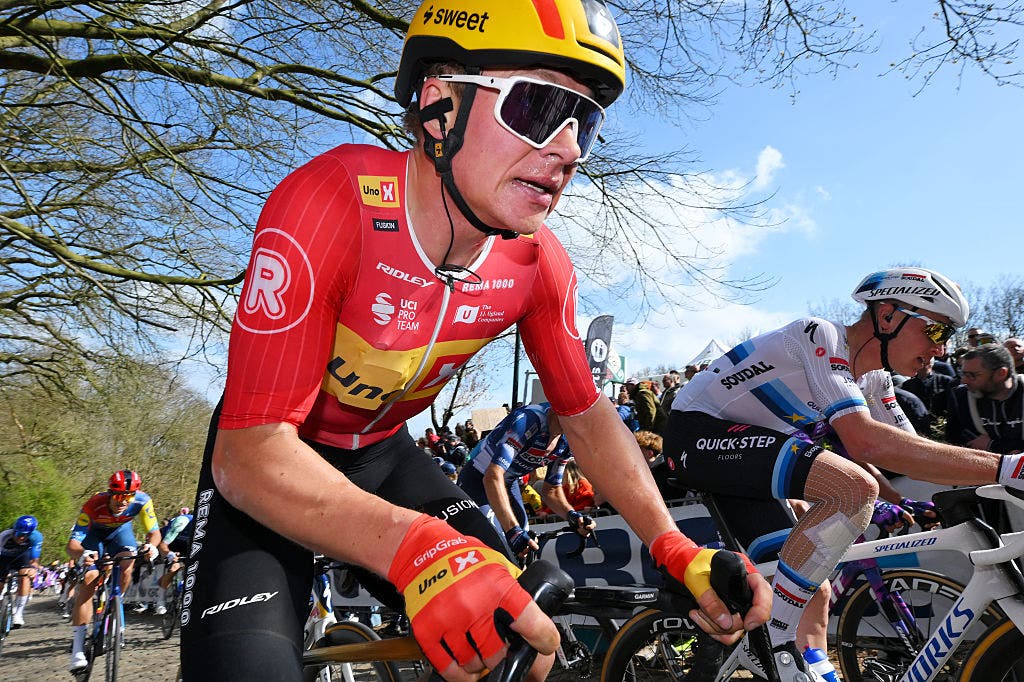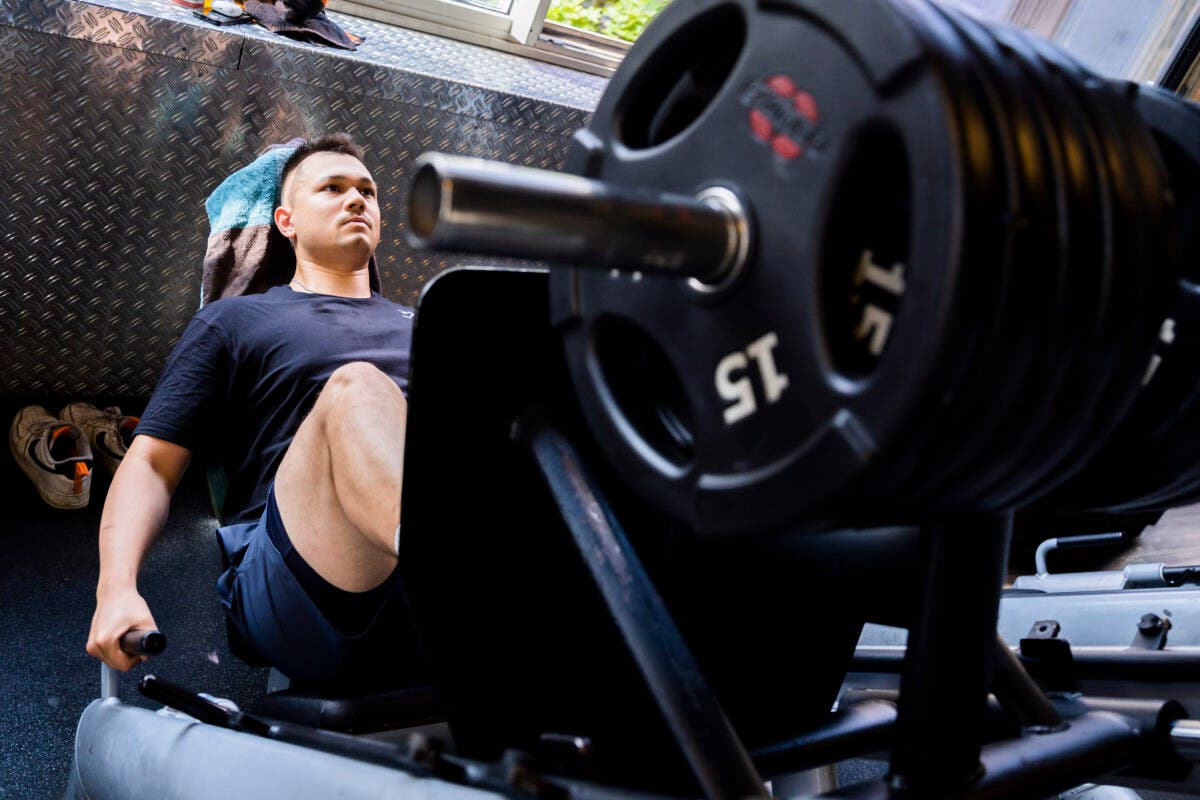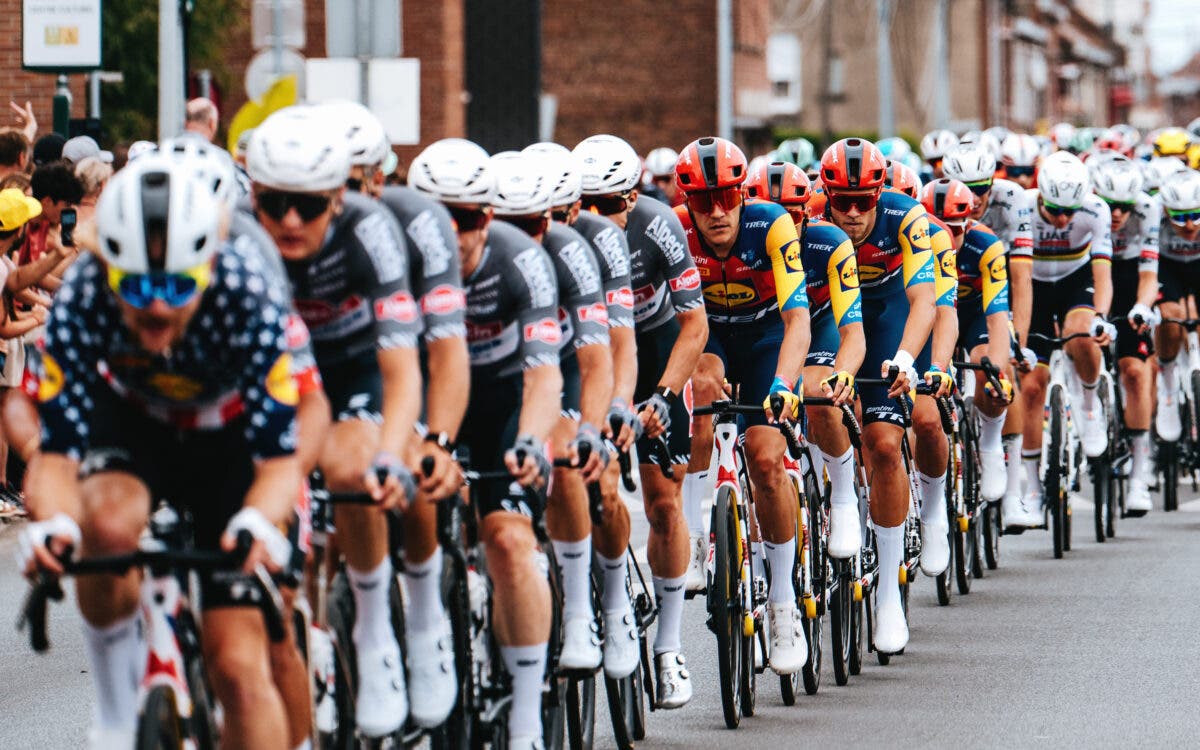Creatine can cause weight gain, but its performance impact is starting to prove too tempting for a sport that’s rethinking w/kg.

(Photo: Gruber Images )
Updated October 14, 2025 06:16AM
Why are scrawny WorldTour pros tapping into creatine, a supplement once reserved for “gym bros?”
Pure and simple – for the gainz.
Skinny Tour de France climbers, strapping cobblestone-bashers, and riders of all sizes in between are learning to overlook worries of “creatine bloat.”
The fast-twitch power-up of the product is just too tempting for a sport that’s shifting its view on watts per kilo.
“A lot of riders used to see creatine as a bodybuilder, ‘gym guy,’ supplement because it was mostly used by strength athletes or sprinters,” said Lidl-Trek nutritionist Stephanie Scheirlynck. “Bike racers always used to stay away.
“However, many of our riders are now taking it, and the number is increasing. I think all riders will use it eventually, when the perception changes,” Scheirlynck told Velo.
As Scheirlynck says, the endurance community is divided over the cost-benefit of creatine.
But the narrative is undoubtedly starting to shift on one of the few proven “game changers” of performance.
A new craze for creatine: ‘A no-brainer to use it’
 Classics specialists, sprinters, and climbers at Uno-X are all dipping in to creatine. (Photo: Tim de Waele/Getty Images)
Classics specialists, sprinters, and climbers at Uno-X are all dipping in to creatine. (Photo: Tim de Waele/Getty Images)
Why the change?
Pumping up power is becoming as much a priority as cutting kilos in the post-pandemic peloton.
“It’s probably one of the most well-researched and safest nutritional supplements out there. The strength benefits are well proven and can be significant,” Team Uno-X Mobility nutrition chief James Moran told Velo.
“It can also help with cognitive fatigue and brain health. For me, it’s a no-brainer for riders to use it,” Moran said.
“But not everybody sees it that way. A lot of people get fixated on possible weight gain.”
Moran estimated that close to half his riders at Uno-X use creatine.
And it’s not only the Scandis. The supplement is becoming a year-long intervention for many more across the top of the sport.
Beyond that, creatine has captured the attention of biohackers, wellness gurus, and national dailies just as much as it has powerlifters and track sprinters.
“Creatine” and “creatine monohydrate” are top #tags in this Gen-Z social era.
Explosive strength, with some bloat
 Creatine is moving out of the gym and into pro cycling. (Photo: Christoph Soeder/picture alliance via Getty Images)
Creatine is moving out of the gym and into pro cycling. (Photo: Christoph Soeder/picture alliance via Getty Images)
So what actually is this substance once hailed a “miracle” fuel?
Creatine is a natural compound made in micro amounts by the liver, kidneys, and pancreas. It helps produce ATP, the primary energy source for muscle contraction.
A creatine overload supercharges the body’s capacity for high-intensity output – whether that’s a 10-second velodrome sprint or a one-rep max squat.
But sadly our internal creatine factories aren’t productive enough to promote performance enhancement. And while creatine is also found in fish and meat, not even a daily T-bone will be enough to get you swoll.
That’s why creatine pills and powders are up there with whey protein and beta alanine as a staple of the strength athlete population, and have been for decades.
A daily dose of creatine saturates the muscles and translates to the plates on the barbell. Better still, it’s easy to access, easy to take, and WADA-approved.
But here’s the thing.
“Creatine bloat” has put the fear into elites competing in weight-governed sports like cycling, running, climbing, and gymnastics. The muscles can retain anywhere between a few grams and multiple pounds of water when supplementing.
That’s why endurance athletes have – until recently – stayed away.
The strength gains couldn’t be squared with the consequence on the bathroom scales.
No consensus from the science
 The performance benefits of creatine are as well-proven as those of caffeine – but the science for weight-governed athletes is still unclear. (Photo: Gruber Images )
The performance benefits of creatine are as well-proven as those of caffeine – but the science for weight-governed athletes is still unclear. (Photo: Gruber Images )
The science on creatine for endurance athletes hasn’t been decisive enough to change minds, either.
One paper from 2024 found no benefits for recovery, body composition, or performance in a sample population of U23 pro cyclists.
Another recent endurance-focused study sat on the fence.
The research concluded that “creatine supplementation appears to be effective at improving performances that require multiple surges in intensity and/or during end spurts, which are often key race-defining moments.”
But it also highlighted that “creatine supplementation increases body mass, which may offset the potential positive effects, particularly in weight-bearing activities.”
‘How we think about creatine has changed a lot’
 Creatine was once reserved for classics specialists and sprinters. Now, the climbers are getting in on the action. (Photo: Gruber Images)
Creatine was once reserved for classics specialists and sprinters. Now, the climbers are getting in on the action. (Photo: Gruber Images)
All this meant that creatine was – until recently – relatively scarce in the racing peloton.
Stage-racers and climbers might have tolerated the bloat during off-season to benefit their winter strength program. They would then cycle off and shed the retained water before race-day 1.
Meanwhile, some sprinters and classics racers might have crushed the creatine all year. Nobody cares about a few extra pounds when they’re pummeling the pavé of Paris-Roubaix.
But the post-pandemic peloton has progressed fast.
For many, creatine is as much of a daily ritual as the pre-ride espresso.
“How we think about creatine has changed a lot in the long time I’ve been in cycling,” Lidl-Trek’s Scheirlynck said.
“Now that riders are strength training all year and not just over the winter, more riders are seeing the benefit of using it in the season. And we know it can help them with strength and concentration on the bike, too.”
Scheirlynck explained how revised approaches to “creatine loading” and daily diet can help riders mitigate the much-feared “bloat.”
“Riders still worry creatine will make them gain weight. But we’re learning that if you approach creatine and overall nutrition the right way, it won’t even happen,” she said. “And we’re educating our riders in that.”
Not all weight is created equal
 Racing is becoming about big power as much as low weight. (Photo: Gruber Images)
Racing is becoming about big power as much as low weight. (Photo: Gruber Images)
Like Scheirlynck said, nutritional and training philosophies have evolved.
The 2025 Tour de France is a different sport from when Chris Froome beat Nairo Quintana and Alejandro Valverde in 2015.
Riders eat twice as much on the bike, attack 100km earlier, and blast new climbing records every passing summer.
And that’s informing the thinking about creatine.
Pro cycling in 2025 is a power sport rather than a weight-loss contest.
“We keep some riders on creatine all year round, maybe more than we would have before,” Moran said. “Other riders phase it in and out.
“We’re finding that the increase in power and strength outstrips any small increases in fluid retention that some riders see.”
Not all weight is equal, after all.
While some “creatine weight” is water, a significant proportion should be muscle.
“Performance is not purely about total weight, but what that might be made up of. If that mass is able to produce high power at the end of four hours of racing, then it’s functional,” Moran said. “It’s not just carrying a rock in your back pocket.”
Should all riders use creatine? ‘It depends’
 Nutritionists believe riders in need of a power boost will most benefit from creatine, but the weight offset remains problematic. (Photo: Gruber Images)
Nutritionists believe riders in need of a power boost will most benefit from creatine, but the weight offset remains problematic. (Photo: Gruber Images)
So should every rider – whether they’re 55kg climber Matthew Riccitello or 75kg watt-monster Wout van Aert – be chewing down creatine?
Tim Podlogar is one of the few pro team nutritionists who’s largely skeptical.
Podlogar worked with Red Bull-Bora-Hansgrohe and is now consulting for Tudor Pro Cycling. He reminded that while cycling is becoming a power sport, it’s still defined by gravity.
Weight control will always be a key area where marginal gains can be made or lost.
“When thinking about creatine, it depends on what the limiting factor for performance is,” Podlogar told Velo.
“If strength is negatively affecting a rider’s performance, then this is a good rationale to use it. But taking it for the sake of getting something that is not a limiting factor … well, it could just work as a placebo.”
Podlogar joined Moran in highlighting that the most waifish climbers and the peloton’s cohort of teenage phenoms are certain candidates for creatine.
Others? For Podlogar, it depends.
“I’d consider it for sprinters, but would be very hesitant for other riders,” Podlogar said. “Perhaps for riders with underdeveloped muscle mass I would consider it as well.”
Moving from the weight room to the mainstream
 Many experts believe its only a matter of time before all endurance athletes – and maybe the general population – will be supplementing creatine. (Photo: Gruber Images)
Many experts believe its only a matter of time before all endurance athletes – and maybe the general population – will be supplementing creatine. (Photo: Gruber Images)
Creatine is moving toward the cycling mainstream. Likewise, triathletes, ultramarathoners, and climbers are curious.
But it clearly remains divisive.
Creatine advocates Moran and Scheirlynck are convinced that it’s only a matter of time before the skeptics change their minds.
“I think it’s one of those supplements that in my lifetime, will be recommended on a population level, like vitamin D,” Moran said. “There are benefits for athletes and huge potential for the general population.
“There’s a lot of research linking dementia and brain health and maintenance of muscle mass as we age, for example.”
Will pro cycling decide the benefits outweigh the bloat?
Check back in a few years’ time.


Dining and Cooking